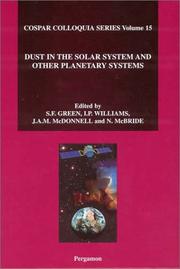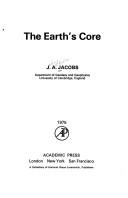| Listing 1 - 7 of 7 |
Sort by
|

ISBN: 9780080530567 0080530567 1281072370 9781281072375 9786611072377 6611072373 9780080441948 0080441947 Year: 2002 Publisher: Boston Pergamon
Abstract | Keywords | Export | Availability | Bookmark
 Loading...
Loading...Choose an application
- Reference Manager
- EndNote
- RefWorks (Direct export to RefWorks)
Since the last joint IAU and COSPAR Colloquium in Gainesville in 1995, there have been dramatic changes in the field resulting from in-situ space experiments, Earth orbiting satellites and ground based observations. The brightest comet since the early years of the twentieth century, comet Hale-Bopp, appeared, giving an invaluable opportunity to see in action one great source of interplanetary dust. Similarly, the Leonid meteor shower has been at its most active since 1966, producing spectacular displays of meteors and allowing for an array of observational techniques, not available in 1966 to
Planets --- Atmospheres.
Multi
ISBN: 0128175257 9780128175255 9780128164907 0128164905 Year: 2020 Publisher: Amsterdam, Netherlands Elsevier
Abstract | Keywords | Export | Availability | Bookmark
 Loading...
Loading...Choose an application
- Reference Manager
- EndNote
- RefWorks (Direct export to RefWorks)

ISBN: 9780080954554 0080954553 1283525224 9781283525220 9786613837677 6613837679 9780123789501 0123789508 Year: 1975 Publisher: New York Academic Press
Abstract | Keywords | Export | Availability | Bookmark
 Loading...
Loading...Choose an application
- Reference Manager
- EndNote
- RefWorks (Direct export to RefWorks)
For advanced undergraduate and beginning graduate students in atmospheric, oceanic, and climate science, Atmosphere, Ocean and Climate Dynamics is an introductory textbook on the circulations of the atmosphere and ocean and their interaction, with an emphasis on global scales. It will give students a good grasp of what the atmosphere and oceans look like on the large-scale and why they look that way. The role of the oceans in climate and paleoclimate is also discussed. The combination of observations, theory and accompanying illustrative laboratory experiments sets this text apart by m
Inner planets. --- Earth --- Core. --- Earth (Planet)
Multi
ISBN: 9780128042014 012804201X 0128041919 9780128041918 Year: 2019 Publisher: Amsterdam, Netherlands Elsevier
Abstract | Keywords | Export | Availability | Bookmark
 Loading...
Loading...Choose an application
- Reference Manager
- EndNote
- RefWorks (Direct export to RefWorks)
"Organized into two main sections, the first half of the book focuses on the Martian meteorites and specific volatile elements. The second half of the book explores processes and locations on the crust, including what we have learned about volatile mobility in the Martian crust. Coverage includes data from orbiter and in situ rovers and landers, geochemical and geophysical modeling, and combined data from the SNC meteorites."--
Volatile organic compounds. --- Cosmochemistry. --- Martian meteorites. --- Mars (Planet) --- Crust. --- Planets
Multi
ISBN: 9783031079238 9783031079221 9783031079245 Year: 2022 Publisher: Cham Springer International Publishing
Abstract | Keywords | Export | Availability | Bookmark
 Loading...
Loading...Choose an application
- Reference Manager
- EndNote
- RefWorks (Direct export to RefWorks)
2022 marks the 45th anniversary of the Voyager probe launches. Launched into space in 1977, these twin probes explored the farthest reaches of the Solar System before venturing on a one-way journey beyond, all the while testing the bounds of science, robotic exploration and our collective imagination. This heavily revised commemorative book takes a comprehensive look at their incredible achievements, future potential and overall legacy. Chronicled herein is an epic journey to unveil the mysterious outer reaches of the Solar System for the first time. The book recounts the Voyagers travels through the asteroid belt and past the giant gaseous planets Jupiter and Saturn, as well as Voyager 2s forays near the distant ice giants Uranus and Neptune. Each chapter details in full the game-changing scientific data and glorious imagery they sent back to Earth. This new edition incorporates all the new data we have learned in the nearly 20 years since its original publication, discussing how the knowledge first gleaned with Voyager has been built upon in subsequent decades by Cassini, Juno and New Horizons. The Voyager probes captured imaginations around the world; now is an opportune time to reflect on their unparalleled quest across the edges of the Solar System and the enigmatic interstellar medium beyond
Space research --- Solar system --- Astronomy --- zonnestelsel --- ruimte (astronomie) --- planeten --- ruimtevaart --- Outer planets. --- United States. --- Solar system.
Multi
ISBN: 9783642320873 9783642320866 Year: 2013 Publisher: Berlin, Heidelberg Springer
Abstract | Keywords | Export | Availability | Bookmark
 Loading...
Loading...Choose an application
- Reference Manager
- EndNote
- RefWorks (Direct export to RefWorks)
Based on the author's own work and results obtained by international teams he coordinated, this SpringerBrief offers a concise discussion of the origin and early evolution of atmospheres of terrestrial planets during the active phase of their host stars, as well as of the environmental conditions which are necessary in order for planets like the Earth to obtain N_2-rich atmospheres. Possible thermal and non-thermal atmospheric escape processes are discussed in a comparative way between the planets in the Solar System and exoplanets. Lastly, a hypothesis for how to test and study the discussed atmosphere evolution theories using future UV transit observations of terrestrial exoplanets within the orbits of dwarf stars is presented.
Solar system --- Astrophysics --- Physics --- Biology --- zonnestelsel --- astrofysica --- biologie --- fysica --- ruimte (astronomie) --- planeten --- Planets --- Planètes --- Atmospheres. --- Atmosphères --- EPUB-LIV-FT LIVPHYSI SPRINGER-B
Multi
ISBN: 9789811917653 9789811917646 9789811917660 9789811917677 Year: 2022 Publisher: Singapore Springer Nature
Abstract | Keywords | Export | Availability | Bookmark
 Loading...
Loading...Choose an application
- Reference Manager
- EndNote
- RefWorks (Direct export to RefWorks)
How planets form is one of the long-standing questions in astrophysics. In particular, formation scenarios of planetesimals which are kilometer-sized bodies and a precursor of planets are still unclear and under debate although some promising mechanisms have been proposed. This book highlight disk instabilities that have the potential to explain the origin of planetesimals. Using linear analyses and numerical simulations, it addresses how a disk evolves through the development of instabilities, and also presents a new instability driven by dust coagulation. As a result, the simulation demonstrates a scenario of planetesimal formation: A successive development of multiple instabilities triggers planetesimal formation in resulting dusty rings.
Solar system --- Astrophysics --- Mathematical physics --- Artificial intelligence. Robotics. Simulation. Graphics --- zonnestelsel --- astrofysica --- mineralen (chemie) --- mijnbouw --- wiskunde --- fysica --- planeten --- Planets --- Protoplanetary disks. --- Origin.
| Listing 1 - 7 of 7 |
Sort by
|

 Search
Search Feedback
Feedback About UniCat
About UniCat  Help
Help News
News